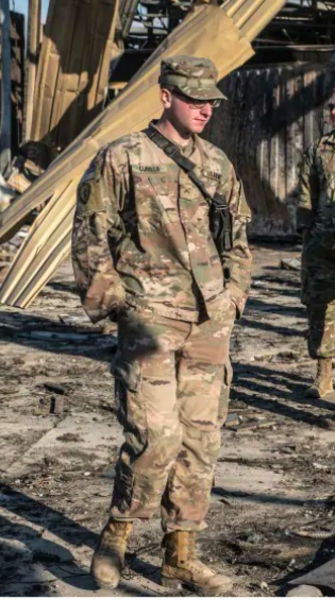Army Hands In Pockets Regulation
Have you ever wondered about the Army's regulation regarding soldiers putting their hands in their pockets? It's a topic that has generated quite a bit of interest and even controversy over the years. In this post, we will explore this regulation and discuss its implications for soldiers. Join us as we delve into the world of soldiers and their hands in pockets!
1. Understanding the History of the Regulation
Before we dive into the specifics of the regulation, let's take a moment to understand its history. The practice of prohibiting soldiers from putting their hands in their pockets dates back to the early days of the US military. At that time, it was believed that soldiers with their hands in their pockets appeared lazy and undisciplined. As a result, rules were put in place to maintain a professional image for the armed forces.
However, as times have changed, so have attitudes towards this regulation. Many argue that it is outdated and unnecessarily strict. Critics argue that soldiers should be allowed to put their hands in their pockets when necessary, especially in cold weather. Let's explore both sides of the argument.
2. The Argument Against the Regulation
Those who oppose the regulation argue that it fails to take into account real-world situations and practicality. They claim that in cold weather, for example, soldiers should be allowed to put their hands in their pockets to protect them from the elements. Furthermore, they argue that this regulation does not reflect the realities of modern military operations, where soldiers often need to multitask and having their hands free can be beneficial.
Additionally, opponents of the regulation suggest that it hinders the development of trust and camaraderie among soldiers. They argue that being able to put one's hands in their pockets can create a more relaxed and comfortable environment, ultimately strengthening the bond between soldiers.
3. The Argument in Favor of the Regulation
On the other hand, supporters of the regulation believe that it maintains a certain level of professionalism and discipline within the military. They argue that a soldier with their hands in their pockets appears less focused and less ready for action. According to them, this regulation serves as a reminder to maintain a high standard of military bearing, which is crucial for public perception and maintaining order within the ranks.
Proponents of the regulation also suggest that it helps to reinforce military traditions and values. They believe that by adhering to this rule, soldiers are reminded of the sacrifices and dedication required of them. Additionally, they argue that this regulation promotes a sense of unity and equality among soldiers, as everyone is expected to follow the same rules.
4. FAQ: Answering Your Questions
Q: What is the exact Army regulation regarding hands in pockets?
A: According to Army Regulation 670-1, soldiers are generally not allowed to have their hands in their pockets while in uniform. However, there are certain exceptions, such as when they are wearing gloves, retrieving an item from the pocket, or using pocketed equipment.
Q: Are there any consequences for a soldier caught with their hands in their pockets?
A: Yes, soldiers who are found with their hands in their pockets when not permitted can face disciplinary action. This may range from a verbal reprimand to more serious consequences, depending on the severity and frequency of the infraction.
Q: Can soldiers put their hands in their pockets during non-formal occasions?
A: It depends on the specific circumstances and the discretion of the commanding officer. While the regulation generally applies to all uniformed situations, there may be instances where soldiers are allowed more flexibility, such as during downtime or non-ceremonial events.
5. Embracing Change and Evolving the Regulation
Given the arguments from both sides, it is worth considering whether the regulation regarding hands in pockets needs to be revisited and revised. The military, like any organization, should continuously adapt to reflect the changing times and circumstances.
Perhaps a compromise can be reached where soldiers are allowed more flexibility in certain situations, such as during extreme weather conditions. By maintaining a balance between professionalism and practicality, the military can ensure that its members can perform their duties effectively while also fostering a sense of trust and camaraderie.
In conclusion, the regulation regarding soldiers putting their hands in their pockets is a topic that elicits strong opinions from both proponents and opponents. While the regulation is rooted in tradition and discipline, it may be time to reevaluate its relevance in the modern military. By engaging in open discussions and considering the needs and perspectives of soldiers, we can work towards a regulation that strikes a balance between professionalism and practicality.
6. Wrapping Up
We hope this post has provided you with a comprehensive understanding of the Army's regulation regarding hands in pockets. It's a complex issue with valid arguments on both sides. Ultimately, it is up to the military leadership to determine the best course of action moving forward.
As always, we welcome your thoughts and opinions on this matter. Do you believe the regulation should be revised, or do you think it should remain as is? Let us know in the comments below!
21 Photos Of US Military Legends With Their Hands In Their Pockets - We
 Image Source : www.wearethemighty.com
Image Source : www.wearethemighty.com pockets wearethemighty
Hands Belong In Pockets! - From The Green Notebook
 Image Source : fromthegreennotebook.com
Image Source : fromthegreennotebook.com pockets hands
Army Hands Over Toilet Blocks To Maligaon And Shantipur Villagers
 Image Source : www.sentinelassam.com
Image Source : www.sentinelassam.com Indian Army Hands Over Boy Who Crossed LOC To Pakistan
 Image Source : www.thehansindia.com
Image Source : www.thehansindia.com Soldiers, Stick Hands In Pockets To Defy Regs Hilariously, Take Them
 Image Source : outsidethewire.armytimes.com
Image Source : outsidethewire.armytimes.com Soldiers Photographed In WaPo With Their Hands In Pockets
 Image Source : taskandpurpose.com
Image Source : taskandpurpose.com syria iraq isis wapo refers taskandpurpose
Why Can't Military Put Hands In Pockets? [Military Rules]
![Why Can't Military Put Hands in Pockets? [Military Rules]](https://www.thesoldiersproject.org/wp-content/uploads/2022/05/military-hands-in-pockets.jpg) Image Source : www.thesoldiersproject.org
Image Source : www.thesoldiersproject.org Soldiers Photographed In WaPo With Their Hands In Pockets
 Image Source : taskandpurpose.com
Image Source : taskandpurpose.com soldiers wapo washington
Soldiers wapo washington. 21 photos of us military legends with their hands in their pockets. Hands belong in pockets!. Soldiers photographed in wapo with their hands in pockets. Army hands over toilet blocks to maligaon and shantipur villagers